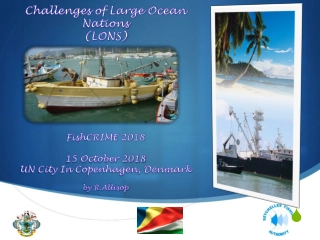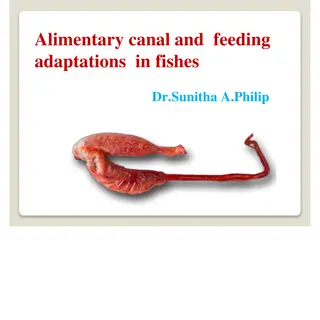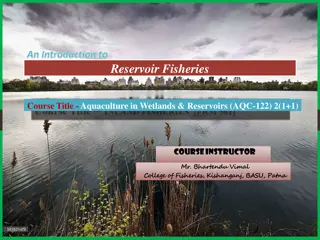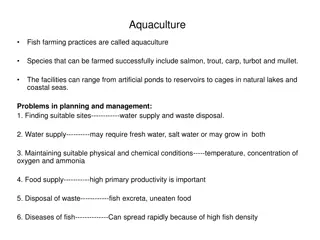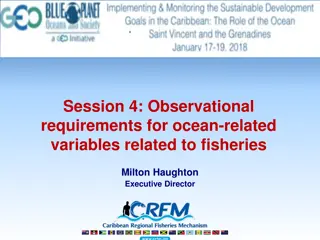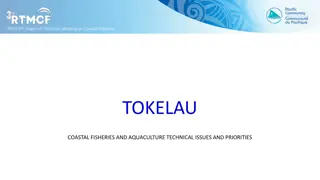Understanding the Lateral Line System in Fishes for Aquaculture & Fisheries
The lateral line system in fishes is a crucial sensory organ that helps in adjusting to water conditions. It comprises the lateral line canal and neuromast organs, providing sensitivity to water currents and pressure. Specializations in different fish groups like sharks and teleosts showcase variations in the development and connectivity of these systems. Neuromast organs play a key role in detecting stimuli, consisting of sensory receptor cells and supporting cells in the grooves of the canal.
Download Presentation

Please find below an Image/Link to download the presentation.
The content on the website is provided AS IS for your information and personal use only. It may not be sold, licensed, or shared on other websites without obtaining consent from the author. Download presentation by click this link. If you encounter any issues during the download, it is possible that the publisher has removed the file from their server.
E N D
Presentation Transcript
Lateralis System in Fishes Course Code: ZOO 636 Course Name: Aquaculture & Fisheries Submitted by: Ms Prabhjot Kaur
Introduction It is system of cutaneous sense organ loged in skin present in all craniates A characteristic set of sense organs found in fishes Fossil fishes also showed traces of these organs It is devised for life in water, helps in adjustment to density, pressure & currents of water Also called mucus canal system It comprises two components viz. the lateral line canal & the neuromast organs
Lateral Line System It exists in form of continuous groove, that follows a definite pattern on head & extends along each side of the body to base of tail Grooves contains the sensory receptors called neuromasts, which are arranged in rows In Chlamydoselachians neuromasts remain exposed In Holocephalians, the grooves remain open In Dipnoans e.g. Protopterus, the canal is partially roofed by bodering denticles & the closed tube of head region opens by minute pores on the surface of the skin The groove of the canal remains filled with a watery fluid in all the fishes & their pore contain a mucoid substances There are many canals in head region, named according to their position:- 1. Main Lateral line canal 2. Supra orbital canal 3. Infra orbital Canal 4. Temporal canal 5. Mandibular canal 6. Preopercular canal
Specialization in lateral Line system in various groups of fishes In Selachi ( Sharks) it runs along the entire length of the body. The supraorbital canal is much developed on the rostrum & joins the infra orbital canal. A transverse commissure joins the right & left supratemporal canal forming an arch over the occipital region The hyomandibular fails to meet post orbital and mandibular is completely separated from hyomandibular. In Actinopterigii, occipital transverse commissure is completely across the middle line The hyomandibular joins the post orbital dorsally Jugal is absent, represented by pit organ in Amia In Dipnoi usual features of Actinopterigii is retained Preoercular fails to reach thepost orbital but jugal is present In Teleosts all the cephalic canals viz. the supra orbital, infra orbital & hyomandibular connect with the lateral line canals of the trunk Supra temporal or occipital canal connects transversely the lateral line canals of the two sides at rear side of the head
Neuromast Organs These are receptor units of lateral line system, found in grooves the canal It consists of two types of cells 1. The sensory receptor/ hair cells ( Pear shaped, found in centre) 2. Supporting cells/ Sustentacular cells ( Long & Slender, forms periphery)
Functions It is receptor for watercurrents, helps fish in orientation Serves as distant touch receptors Helps in locating objects at a distance Respond to pressure changes Principle of ecolocation is used to detect object in darkness or in turbid medium Gives the schooling ability to fishes, in which fish of a school reacts to the movement of its closest neighbour.
Special types of Neuromasts Ampullae of Lorenzini Pit organs The vesicles of Savi Mormyromasts


